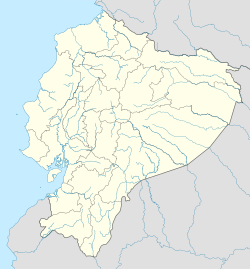| This article needs additional citations for verification. Please help improve this article by adding citations to reliable sources. Unsourced material may be challenged and removed. Find sources: "Balzar, Ecuador" – news · newspapers · books · scholar · JSTOR (November 2023) (Learn how and when to remove this message) |
| Balzar | |
|---|---|
| City | |
 Coat of arms Coat of arms | |
 | |
| Coordinates: 1°21′58″S 79°54′21″W / 1.36609°S 79.90580°W / -1.36609; -79.90580 | |
| Country | |
| Province | Guayas |
| Canton | Balzar Canton |
| Area | |
| • City | 10.65 km (4.11 sq mi) |
| Population | |
| • City | 32,744 |
| • Density | 3,100/km (8,000/sq mi) |
Balzar is a city located in northern Guayas Province, Ecuador, on the Daule River, near Los Ríos Province. It is the seat of Balzar Canton, and the agricultural center in northern Guayas.
As of the census of 2022, the city had a population of 32,744.
The most important river is the Daule River, used for transportation. Agriculture is the main activity. Rice, coffee and tobacco are the most important products. Balzar is famous throughout Ecuador for the tall tree located at the end of the main road. Balzar became a canton on September 26, 1903
1°22′S 79°54′W / 1.36°S 79.90°W / -1.36; -79.90
History
| This section does not cite any sources. Please help improve this section by adding citations to reliable sources. Unsourced material may be challenged and removed. (May 2020) (Learn how and when to remove this message) |
In 1964 a Danish agricultural engineer and pioneer in organic farming, bought the farm Hacienda Karen, located on the Rio Daule banks some miles from Balzar, from Shell director Hans Bach. Carl Vilhelm Dencker-Rasmussen, on purchasing the Hacienda, experimented in rubber planting, tobacco growing and rice planting. The rice planting was done at a strategically important time of the year when the rains came. Channels were dug like the rice fields Dencker-Rasmussen had seen in Malaysia many years before, resulting in successful crops. Rice had previously been brought in from outside and eventually became one of the important alternative staple diets for the region instead of the sweet potato and maize traditionally used.
Climate
| Climate data for Balzar, elevation 40 m (130 ft), (1971–2000) | |||||||||||||
|---|---|---|---|---|---|---|---|---|---|---|---|---|---|
| Month | Jan | Feb | Mar | Apr | May | Jun | Jul | Aug | Sep | Oct | Nov | Dec | Year |
| Mean daily maximum °C (°F) | 30.2 (86.4) |
30.6 (87.1) |
31.4 (88.5) |
31.1 (88.0) |
30.8 (87.4) |
28.7 (83.7) |
28.6 (83.5) |
29.6 (85.3) |
30.3 (86.5) |
30.0 (86.0) |
30.1 (86.2) |
30.7 (87.3) |
30.2 (86.3) |
| Mean daily minimum °C (°F) | 21.4 (70.5) |
22.0 (71.6) |
22.4 (72.3) |
22.4 (72.3) |
21.9 (71.4) |
20.8 (69.4) |
20.0 (68.0) |
20.0 (68.0) |
20.0 (68.0) |
20.4 (68.7) |
20.0 (68.0) |
21.1 (70.0) |
21.0 (69.9) |
| Average precipitation mm (inches) | 332.0 (13.07) |
384.0 (15.12) |
470.0 (18.50) |
292.0 (11.50) |
90.0 (3.54) |
24.0 (0.94) |
3.0 (0.12) |
3.0 (0.12) |
8.0 (0.31) |
5.0 (0.20) |
9.0 (0.35) |
89.0 (3.50) |
1,709 (67.27) |
| Average relative humidity (%) | 81 | 82 | 85 | 83 | 84 | 84 | 84 | 79 | 77 | 78 | 76 | 77 | 81 |
| Source: FAO | |||||||||||||
References
- Citypopulation.de Population and area of Balzar
- "CLIMWAT climatic database". Food and Agriculture Organization of United Nations. Retrieved 20 June 2024.
This Ecuador location article is a stub. You can help Misplaced Pages by expanding it. |